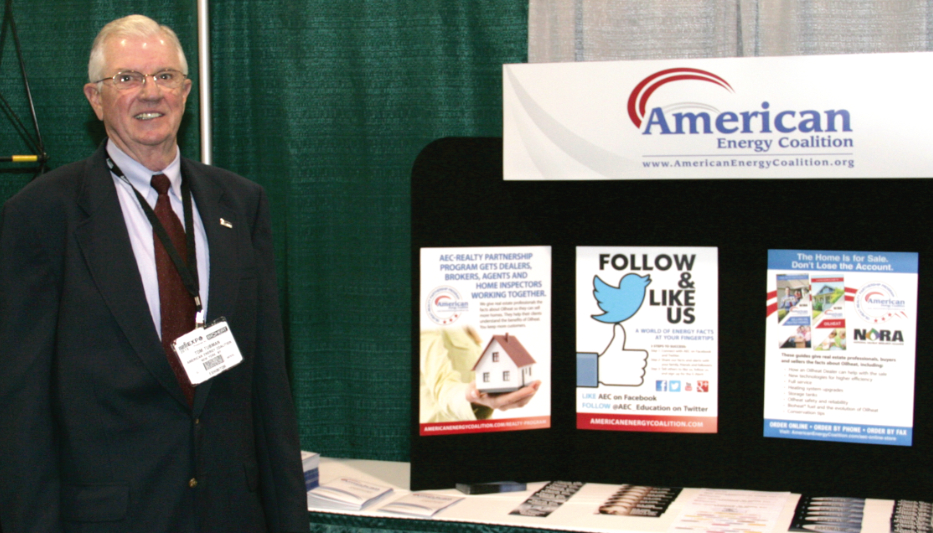All
Parting Words: An Interview with Tom Tubman
by Rhonda Gerson

Oil & Energy’s exclusive interview on his retirement as AEC Executive Director
The American Energy Coalition (AEC) was officially formed in late 2008 in response to the misinformation and threats from natural gas utilities promoting conversions from home heating oil to their “cleaner, less expensive” energy. The founding coalition members were owners and executives of concerned fuel retailers, wholesalers, manufacturers and affiliated industry partners. After a few years of organizing and fundraising duties squeezed in between their responsibilities to their companies, other associations, community organizations … and, oh yes, their families, they realized they needed someone to lead AEC full time. Enter Tom Tubman, installed as AEC’s first executive director on February 1, 2011.
Tubman “officially” retired on March 31, 2023. But he’s not quite done yet. As a final example of his dedication to the association and the industry, he has agreed to represent AEC at trade shows through the spring and summer, giving the Board time to find his successor.
He generously agreed to be interviewed by Oil & Energy and talk about the changes he has seen over the last dozen years as well as the challenges to come and give us a deeper glimpse of his personal history. (Personal note: As part of my previous responsibilities at PriMedia, I have worked closely with Tom, from just about his first day on the job, on many AEC projects. It was my pleasure and my honor to come full circle and conduct his final interview as executive director.)
Challenges, Changes and Rewards
“The best part of this position is the people you deal with, from the state association executives to the wholesalers and manufacturers, to the retailers,” Tubman said. “Just being able to network with folks in the industry, folks I’ve known for 40-50 yrs … I don’t think you’ll find an industry with better people than our industry. Being able to work as a team and have everyone pull in the same direction were some of the best experiences of my life. It’s a good industry, good people; everyone having the same hopes, wants and desires.”
Of course, not everything was always rosy. For every “best part,” there was a counterpoint. “The most frustrating part of what I’ve done for the last 12 years is the difficulty, or challenge, in having our voice heard, and having misinformation put out there by our competitors, and not having the same amount of lobbying ability that the utilities and the environmental bloc have. It’s been frustrating,” he stated. Promoting liquid heating fuels to the end, he continued, saying, “We have a good story to tell. If we could be heard, we have a better story and a better product for homeowners in terms of cost and carbon reduction. It is frustrating to try to get the message out to the people who need to hear it. To some degree, some of the challenges we have are more difficult than the challenges that face our [better funded] adversaries.”
As any reader of Oil & Energy knows, there have been a lot of changes over the years, and Tubman has had a front row seat. “Certainly, the threats to the industry have changed. Twelve years ago, it was aggressive utilities trying to bring in new pipelines and convert homes to natural gas. Now it’s electrification and carbon reduction. Associations have had to change their focus. The challenges get more difficult as time goes on. It’s more difficult to fight against electrification than gas conversions.”
It’s not just the external challenges, either. “I’ve seen a number of changes over the years. One is in the organizations themselves. With business consolidations and acquisitions, membership has shrunk in the state associations, which can create issues for them in terms of budgets, donations, and funding for outreach,” he explained. “I’ve also witnessed considerable changes in the fuel itself, from heating oil to low sulfur to ultra-low sulfur to Bioheat® fuel. That can become an issue for the associations to deal with, as implementation and specifications change from one state to another. That’s been a significant change.”
We asked Tubman to look into his crystal ball to predict the future for the liquid fuels industry. “It all depends upon how the rollout for electrification transpires. Right now, we have ISO New England warning that there’s not enough generation capacity with the retirement of coal and natural gas plants. Last year, New York ISO came out with a similar message. In the last week or two, we heard from PJM Interconnection, which manages the electric grid in 13 states south and west of New York. PJM didn’t have a high volume of renewables, but they had a lot of coal generation. They used to generate more electricity than they needed and exported their surplus to other regions’ grid operators.” Tubman referenced a Wall Street Journal editorial from February 27, “S.O.S. for the U.S. Electric Grid,” and continued. “Now PJM is saying ‘we’re retiring coal and natural gas power plants too quickly, and we can’t replace that capacity. We can’t meet that.’ They are anticipating 40,000 megawatts of power generation will be retired by 2030 – that’s 21% of their generating capacity. They won’t be able to export excess power to neighboring regions, because they won’t have it. Which will mean more blackouts in the entire region. It’s clear that how the whole electrification thing transpires over the next few years will have a big impact on our industry’s future.”
A Day in the Life
Naturally, the conversation turned to thoughts about his successor and what he or she might expect on any given day. “There is no average day,” said Tubman. “If I wasn’t traveling, the first thing I would do is read four newspapers a day to stay on top of what’s going on in the energy sector, both positive and negative. It is important information we can use and share.”
But that was just the basic framework. “There are some things that you must do every day, like monitoring emails, replying to correspondence, making telephone calls and, over the last three years, signing into Zoom Meetings. There’s a lot that’s different, too. I might be going to a trade show or an evening meeting or preparing a PowerPoint presentation. If I’m going to an event, for instance, travel could take up most of the day. Some places are more than 350 miles away – that’s five or six hours of driving,” he continued. “The other part, of course, was working with PriMedia to develop marketing materials and campaigns: the ads, brochures, data sheets, postcards and other assets that had to be relevant to the time and the challenges the state and regional associations are facing. I don’t want to underestimate the work with PriMedia. There were days I spoke to John Bruno more often than I talked to my wife! I might give a general concept or direction of what we wanted to convey, but PriMedia created it.”
Thinking some more on who his successor might be, Tubman said, “I would hope that whoever they select is a veteran of our industry, knows the industry well, and can step in and do what AEC needs them to do. I have been honored to serve in this position; honored to work with an exceptional organization like AEC and maintain contacts at the highest levels in all the state and national organizations and our generous supporters from manufacturing, supply houses, retailers, wholesalers. I hope whoever succeeds me will appreciate the value of AEC and take it to the next level; that they would be humble enough to appreciate the opportunity that they are given.”
Looking Back, Looking Forward
Tubman traces his 54-year career in the energy industry to his first job as a truck mechanic in Providence, 1969 while pursuing a degree in Mechanical Engineering. The bus company he worked for was sold to White Fuel Co., and the rest is history. While at White Fuel, Tubman helped design the first thermo-solar systems and their company eventually became the northeast distributor for Grumman Solar Systems. He saw White Fuel and its customers through the Arab oil embargoes of the 1970s and standardized the company’s operations and training programs, among others. In 1983 he joined Power Flame, where over the course of 15 years he moved to Kansas, helped break the glass ceilings for female employees, and brought their parts ordering division from last place in customer service to first – thanks to one of the female staffers he promoted over the skepticism of the owner and other managers.
From Power Flame, Tubman moved to Carlin and returned to his East Coast roots. Twelve plus years later, he helped broker the sale of the company and then it was soon time to move on. “And that’s when Judy Garber called and said they needed a leader for the American Energy Coalition.”
Future plans are up in the air. For now, Tubman will be spending time with Dorothy, his wife of 38 years. Odds are, there will be visits with his three children, two stepchildren and ten grandchildren filling many of those days. Maybe he’ll even cut down to reading only three newspapers a day.
Related Posts
 Why Quality Matters in Your Biofuel Blends
Why Quality Matters in Your Biofuel Blends
Posted on June 25, 2025
 HEAT Show Gears Up
HEAT Show Gears Up
Posted on June 25, 2025
 What’s Next in Boiler Technology
What’s Next in Boiler Technology
Posted on June 25, 2025
 How Intelligent Are Your Integrated Customer Platforms?
How Intelligent Are Your Integrated Customer Platforms?
Posted on June 25, 2025
Enter your email to receive important news and article updates.
